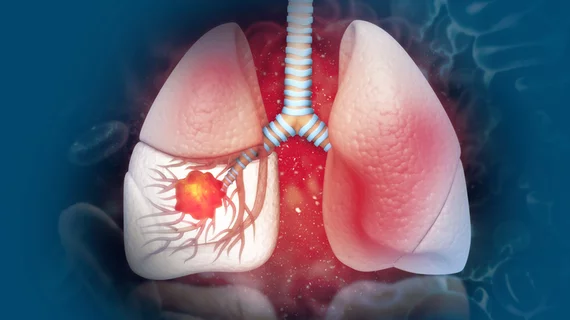Hybrid lung cancer screening program could save Medicare millions in follow-up spending
A new strategy for managing nodules during baseline lung cancer screening could eliminate many unnecessary follow-up visits and slash Medicare spending by millions, according to new estimates published Tuesday.
The technique combines the Lung CT Screening Reporting and Data System (Lung-RADS) with artificial intelligence-based malignancy risk scoring to improve the accuracy of screening exams. Using the AI-informed strategy ballooned specificity to 96% up from 66% when using Lung-RADS alone, Canadian researchers explained in JACR.
And after comparing the cost differences between Lung-RADS-recommended follow-up procedures to the hybrid management strategy, the researchers found the latter would save, at a minimum, $72 per patient and a maximum of $242 per person.
Scott J. Adams, MD, and colleagues with the University of Saskatchewan in Canada noted savings would likely fall closer to the minimum. But they estimated their screening approach could save millions.
“In 2016, Roth et al. estimated that cost savings using Lung-RADS compared with management as per the NLST protocol would result in a $316 million ($2 per member, per year) reduction in Medicare expenditure over three years,” Adams, with the university’s medical imaging department, and colleagues explained. “Our findings suggest that an AI algorithm applied to baseline lung cancer screening studies could provide further cost savings in the first year after screening as a result of the increased specificity achieved using AI (with sensitivity maintained or increased).”
For their study, the group applied its model to a dataset of AI malignancy risk scores and Lung-RADS classifications performed by six radiologists. In total, 192 low-dose CT exams were included and weighted to represent 3,197 baseline screening patients. Follow-up exam costs were determined using the 2019 U.S. Medicare Physician Fee Schedule.
The AI-powered strategy upgraded 41 (0.2%) Lung-RADS category 1 or 2 cases to category 3, those requiring additional investigations. On the other hand, 5,750 (30%) category 3 or higher diagnoses were downgraded to category 2, for which no interval investigations are recommended.
Adams and colleagues noted their study assumed perfect compliance with follow-up recommendations and also likely overestimates real-life cost savings but maintained that the figure would still be impactful.
“Our study suggests that using an AI risk score in combination with Lung-RADS at baseline LDCT lung cancer screening can result in substantial cost savings due to increased specificity and fewer interval follow-up investigations,” the authors concluded. “The AI-informed management strategy proposed here provides a simple and practical example of how AI for risk stratification can be combined with Lung-RADS to inform management recommendations after baseline lung cancer screening.”
You can read the entire analysis published Jan. 19 in the Journal of the American College of Radiology here.

